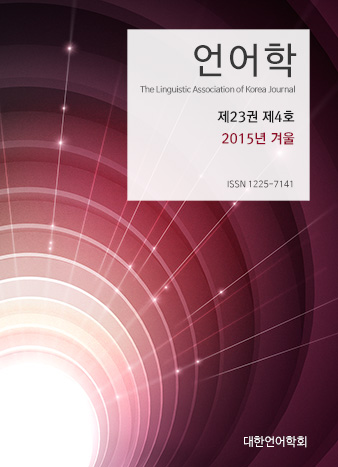대한언어학회 전자저널

Abstract
Lee, Heedoo. (2015). Phonological change of the rising diphthongs and dispersion effects. The Linguistic Association of Korea Journal 23(4), 239-258. /jə/ and /ə/ after consonants were perceptually confused with each other in Middle Korean because the articulatory domain of /ə/ was placed in the front area of the phonetic vowel system and so was overlapped with the auditory domain of /jə/. For escaping this perceptual confusion the dispersion effects work here. Therefore the falling glide /j/ was inserted to the end of /jə/ in order to increase F2. As the result of the glide epenthesis, /jəj/ was maximally contrasted with /ə/ by the minimization of perceptual confusion and /jəj/ developed diachronically through the process of /jəj/>/je/>/e/. Also /jə/ has synchronically been alternated with /e/ by the dispersion effects in some dialects in which /jə/ is articulated in the front area.
Keywords
# 활음 j 첨가(j-addition) # 산포효과(dispersion effects) # 대립의 변별성(distinctiveness of contrasts)
References
- 곽충구. (1982). ‘왕겨’의 방언형들의 분포와 그 비교 연구. 개신어문연구 2. 1-14.
- 김봉국. (2002). 강원도 남부지역 방언의 음운론. 서울대 박사학위논문.
- 김성규. (2003). ‘여>예>에’의 변화 과정에 대하여. 관악어문연구 28, 161-182.
- 김완진. (1963). 국어 모음체계의 신고찰. 진단학보 24, 475-511.
- 김진우. (1968). The vowel system of Korean. Language 44.
- 김주필. (1985). 구개음화에 대한 통시론적 연구. 서울대 석사학위논문.
- 김현. (2009). ‘ㅕ>ㅔ’에 대한 음성학적 접근. 개신어문연구 29, 65-27.
- 김형규. (1974). 한국방언연구. 서울: 서울대 출판부.
- 박숙희. (1998). 영일지역어의 형태음운론적 연구. 충남대 석사학위논문.
- 배주채. (1994). 고흥방언의 음운론적 연구. 서울대 박사학위논문.
- 백두현. (1992). 영남 문헌어의 음운사 연구. 서울: 태학사.
- 안상철. (2003). 최적성 이론의 언어분석. 서울: 한국문화사.
- 오종갑. (1983). ㅑ, ㅕ, ㅛ, ㅠ의 변천. 국어학논집 10, 285-305.
- 오종갑. (1999). y계 이중모음의 변화와 관련된 영남방언의 특성과 그 전개. 인문연구 36, 1-45.
- 유창돈. (1964). 이조국어사연구. 서울: 선명문화사.
- 이광호. (1977). i 모음화의 음운론적 해석. 어문학 36. 77-92.
- 이숭녕. (1954). 순음고. 논문집1(서울대), 40-76.
- 이진호. (2002). 음운 교체 양상의 변화와 공시론적 기술. 서울대 박사학위논문.
- 이희두. (2014). 한국어 체언 말 설정장애음의 마찰음화 교육. 언어학 22.4, 183-201, 대한언어학회.
- 정승철. (2004). j계 상향이중모음의 변화 - 형태소 내부를 중심으로. 언어학연구 9-1, 43-58, 제주언어학회.
- 정승철. (2008). 방언형의 分布와 改新波-兩脣音 뒤 j계 上向 二重母音의 縮約 現象을 중심으로-. 어문연구 36.2, 99-116.
- 최임식. (1984). 19세기 후기 서북방언의 모음체계. 계명대 석사학위논문.
- 최명옥. (1982). 월성지역어의 음운론. 대구: 영남대 출판부.
- 최명옥. (1995/1998). ‘Xㅣ] Vst 어 Y’의 음운론. 국어음운론과 자료, 서울: 태학사, 291-322.
- 최태영. (1983). 방언음운론-전주 지역어를 중심으로. 서울: 형설출판사.
- 최전승. (1986). 19세기 후기 전라방언의 음운현상과 그 역사성. 서울: 한신문화사.
- Boersma, Paul, and Hamann, Silke (2007). The evolution of auditory contrast. ROA 909.
- Flemming, Edward (1995). Auditory representation in phonology. Doctoral dissertation, UCLA. [Published 2002 by Routledge, New York & London]
- Flemming, Edward (2004). Contrast and perceptual distinctiveness, in the Phonetically based phonology. Hayes, B., Kirchner, R. & Steriade, D.(eds.), Cambridge University Press.
- Lindblom, Björn (1986). Phonetic universals in vowel systems. In John Ohala and Jeri Jaeger (eds.) Experimental phonology. Orlando: Academic Press. 13-44.
- Lindblom, Björn (1990). Explaining phonetic variation: a sketch of the H&H theory. In William Hardcastle and Alain Marchal (eds.) Speech production and speech modelling. Dordrecht: Kluwer. 403-439.
- Steriade, Donca (1997). Phonetics in phonology: the case of laryngeal neutralization. Ms., University of California.